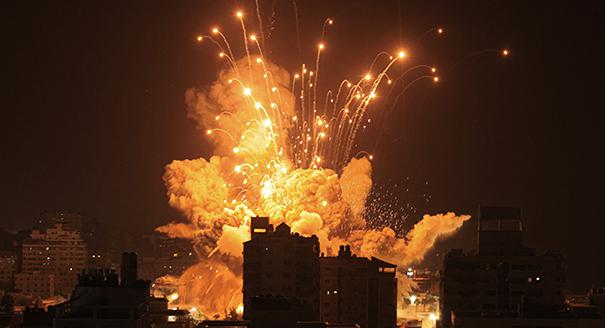Hamas’s surprise attack against Israeli towns around Gaza on October 7 upended several dynamics that had increasingly defined regional politics in recent years. The first and most obvious one was the fallacy that the issue of Palestine and the Palestinians no longer mattered to the Arabs, and that achieving stability in the region was possible even though the Palestinians remained under a particularly brutal form of Israeli occupation. Popular reactions have shown that Palestinians and the injustices they face remain emblematic political issues capable of galvanizing anger in the Arab world more than all others.
Fury with Israel’s treatment of the Palestinians, which was palpable in Arab public opinion prior to October 7, is deepening. It is also provoking a growing anti-Western mood, because the United States and many countries in Western Europe appear to be giving blanket support for Israel’s bombardment of Gaza. This has put Palestine back at the center of public discourse, has reinvigorated calls for a political solution to the Palestinian problem, and has refocused discussion on achieving a one-state reality in light of the impossibility of a two-state solution. The public outcry in the region and accusations of double standards directed against Western countries have also eroded much of the diplomatic effort to drum up support from key countries in the global south for Ukraine in its conflict with Russia, and for the need to uphold a rules-based international order.
Second, October 7 put the process of normalization between a number of Arab states and Israel—known collectively as the Abraham Accords—in deep freeze. These accords aimed to create a new security and economic architecture that mainly included Gulf Arab countries and Israel, and that were gradually integrating Israel into the region. But they undermined the principle of land for peace embodied in Security Council Resolutions 242 and 338, which was reaffirmed by the Arab Peace Initiative of 2002. This left Palestinians without regional backers, allowing Iran to fill the void. Through the Abraham Accords, the United States, the accords’ main impresario, focused mainly on the Gulf countries while sidelining those of the Levant, and with them the Palestinians. Washington’s recently announced India-Middle East-Europe trade route, which would link India to the Gulf region and then to Israel, only underscored this.
The most significant pillar of this new regional order was to be the normalization of relations between Saudi Arabia and Israel, which was still being negotiated at the time of the attack. As a result of the conflict in Gaza, these negotiations have been indefinitely suspended. In countries that have signed accords with the Israelis, the public mood is largely opposed to Israel because of the slaughter of Palestinians in Gaza and the rising number of attacks against Palestinians in the West Bank, as well as their dispossession. The revival of Saudi-Israeli talks will be contingent on the cessation of hostilities, political outcomes that address the catastrophic condition of Palestinians, and the shape of a new Israeli government.
A third assumption that October 7 may have overturned was that Iran’s efforts over the decades to consolidate its regional influence were beginning to bear fruit. Earlier this year, the rapprochement between Saudi Arabia and Iran reflected Riyadh’s implicit recognition of Iran’s network of nonstate actors across key countries in the Middle East, including Syria, Iraq, Lebanon, and Yemen. Whereas Saudi leaders had once denounced the “snake” of Iranian influence, they were now willing to pragmatically deal with Tehran. At the same time, there was progress in the U.S.-Iran dialogue, through a deal to release five detained American dual nationals in exchange for $6 billion worth of frozen Iranian assets in South Korea. Iran had also used its proxies to successfully encircle Israel with successive lines of deterrence, from Lebanon, Gaza, Syria, and further afield in Iraq and Yemen.
Today, all this is in jeopardy. Hamas’s perhaps inadvertent operational success has taken the region, and with it the world, to the edge of a regional and potentially global conflict. The rising casualty toll among Palestinians, with around 9,000 people killed and over 22,000 injured, according to the United Nations Office for the Coordination of Humanitarian Affairs, and some 30 percent of the housing units in Gaza destroyed, is putting pressure on Iran’s “unity of the fronts” strategy. Tehran is not keen to be involved in the conflict, but after unifying its allies in Lebanon, Gaza, Syria, and the West Bank in their fight against Israel, it also cannot afford to do nothing if Hamas is threatened. On the other hand, the Iranians know that any intervention could be catastrophic if it directly threatens the regional assets it has spent the better part of three decades building up.
To square the circle, Hezbollah has adopted an incremental form of escalation with Israel along Lebanon’s southern border. Up to now, this has remained contained. However, the beginning of direct attacks against Israel by pro-Iranian groups from Iraq, Yemen, and Syria are placing the region on a slippery slope that could trigger a much broader conflict. That is why those who are urging Israel to seek maximalist goals in its Gaza intervention could be pushing their ally, and the world, toward a catastrophe. The threat of regional escalation is high and is likely to draw in global powers. The October 7 attacks may have upended the region, but few have any interest in seeing them upend the international order.







